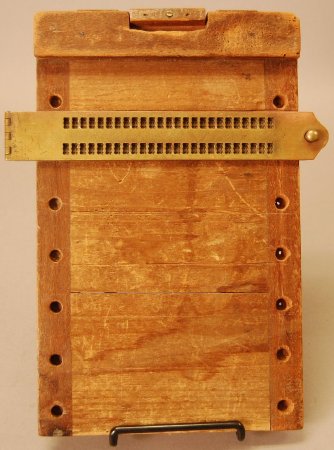Object ID:
2001.211.136
Title:
Braille Interlining Guide, small size
Description:
Wooden desk slate; (a) board; two solid wood side rails of darker wood, attached to main board with glue and three (3) screws through sides, each rail has seven (7) 5/16" diameter holes bored in a vertical line; wooden full width paper clamp at top of board, hinged with two brass curled piano hinges, cutout in center of clamp for fixed block mounted with screw for clamp lock, clamp has steel teeth both up and down (total of four); ; stamped on top of left rail behind clamp, "BA"; (b) hinged brass desk slate for interlining braille, rounded point on open end, curled piano hinge on opposite end; two (2) lines of 25 cells; 1 large blunt pin on front of bottom plate which fits through hole in top frame when closed; two pegs on back to fit holes in smooth board; "7" stamped on top and bottom frames.
Date:
ca. 1900
Made by:
British & Foreign Association for Promoting the Education and Employment of
Place of Origin:
London, England
Provenance:
The British & Foreign Association for Promoting the Education and Employment of the Blind, founded in 1868, was listing large and small interlining frames for braille as early as 1882. The "BA" became the National Institute for the Blind in 1914. Braille slates were difficult to find in the U.S. prior to 1900. British slates and braille materials were listed in the annual reports of the Perkins School throughout the 1870s as a potential source, and the school noted that its students used British "tablets" in its 1874 report.In 1920, NIB expanded its mandate to include the production and sale of "Apparatus for Use by the Blind" and produced its first catalog soon after. This model became NIB catalog#9019 (hinged) and 9021 (small size board).
Item is part of a slate collection that belonged to David Ronecker (1918-2001). Blind since birth, he attended the Missouri School for the Blind, worked in Texas as a medical technician for the armed forces, and was an avid collector of slates. He was the uncle of Charles Zinser, who acquired the slate collection after Ronecker's death.
Item is part of a slate collection that belonged to David Ronecker (1918-2001). Blind since birth, he attended the Missouri School for the Blind, worked in Texas as a medical technician for the armed forces, and was an avid collector of slates. He was the uncle of Charles Zinser, who acquired the slate collection after Ronecker's death.
Credit Line:
Museum Purchase, 2001.211
